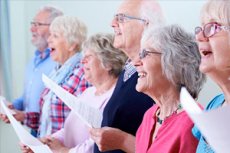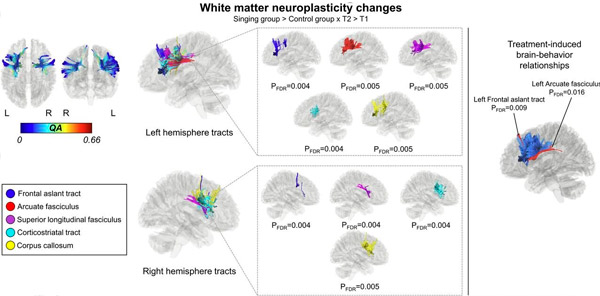Nye publikasjoner
Sang gjenoppretter tale ved afasi etter hjerneslag
Sist anmeldt: 02.07.2025

Alt iLive-innhold blir gjennomgått med medisin eller faktisk kontrollert for å sikre så mye faktuell nøyaktighet som mulig.
Vi har strenge retningslinjer for innkjøp og kun kobling til anerkjente medieområder, akademiske forskningsinstitusjoner og, når det er mulig, medisinsk peer-evaluerte studier. Merk at tallene i parenteser ([1], [2], etc.) er klikkbare koblinger til disse studiene.
Hvis du føler at noe av innholdet vårt er unøyaktig, utdatert eller ellers tvilsomt, velg det og trykk Ctrl + Enter.

Cerebrovaskulær sykdom, eller hjerneslag, er den vanligste årsaken til afasi, en språkforstyrrelse forårsaket av hjerneskade. Personer med afasi har problemer med å forstå eller produsere tale eller skriftlig språk. Det er anslått at omtrent 40 % av personer som har hatt hjerneslag har afasi. Halvparten av disse personene har fortsatt symptomer på afasi selv et år etter det første anfallet.
Tidligere har forskere fra Universitetet i Helsingfors funnet ut at sang bidrar til å gjenopprette talen hos slagpasienter . Nå har de funnet ut årsaken til den rehabiliterende effekten av sang. Den nylig avsluttede studien ble publisert i tidsskriftet eNeuro.
Ifølge funnene gjenoppretter sang hjernens strukturelle språknettverk. Språknettverket behandler språk og tale i hjernen vår. Hos pasienter med afasi er dette nettverket skadet.
«For første gang viser resultatene våre at rehabilitering av pasienter med afasi gjennom sang er basert på nevroplastisitet, det vil si hjernens plastisitet», sier forsker Aleki Sihvonen ved Universitetet i Helsingfors.
Sang forbedrer språknettverksveier
Språknettverket omfatter kortikale områder i hjernen som er involvert i behandling av språk og tale, samt hvit substans, som overfører informasjon mellom forskjellige områder av cortex.
Ifølge studien øker sang volumet av grå substans i språkområdene i venstre pannelapp og forbedrer tilkoblingen av nervebanene, spesielt i språknettverket i venstre hjernehalvdel, men også i høyre hjernehalvdel.
«Disse positive endringene var knyttet til forbedret taleproduksjon hos pasienter», sier Sihvonen.

Behandlingsinduserte endringer i nevroplastisitet i hvit substans. Konnektometriresultater viser signifikante traktsegmenter med økninger i longitudinell QA signifikant assosiert med sanggruppen sammenlignet med kontrollgruppen mellom T1 og T2 (ΔT2–T1; venstre) og en korrelasjon av endringer i longitudinell QA med forbedring av navngivning (høyre). Kilde: eneuro (2024). DOI: 10.1523/ENEURO.0408-23.2024
Totalt 54 pasienter med afasi deltok i studien, hvorav 28 gjennomgikk MR-skanning i begynnelsen og slutten av studien. Forskerne undersøkte rehabiliteringseffektene av sang gjennom korsang, musikkterapi og sangøvelser hjemme.
Sang som en kostnadseffektiv behandling Afasi har en bred innvirkning på funksjonsevnen og livskvaliteten til de berørte, og fører lett til sosial isolasjon.
Sihvonen mener at sang kan sees på som et kostnadseffektivt tillegg til tradisjonelle former for rehabilitering eller som rehabilitering for milde taleforstyrrelser i tilfeller der tilgangen til andre former for rehabilitering er begrenset.
«Pasienter kan også synge sammen med familiemedlemmer, og sang kan organiseres i helsevesenet som en gruppe, en kostnadseffektiv rehabilitering», sier Sihvonen.
